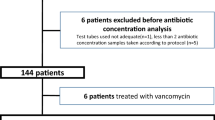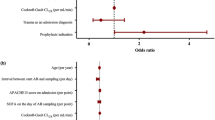Abstract
Patients in the intensive care unit (ICU) are at risk for suboptimal levels of β-lactam antibiotics, possibly leading to poor efficacy. Our aim was to investigate whether the actual minimum inhibitory concentration (MIC) compared to the more commonly used arbitrary epidemiological cut-off values (ECOFFs) would affect target attainment in ICU patients on empirical treatment with broad-spectrum β-lactam antibiotics and to identify risk factors for not reaching target. In a prospective, multicenter study, ICU patients ≥18 years old and treated with piperacillin/tazobactam, meropenem, or cefotaxime were included. Clinical and laboratory data were recorded. Serum trough antibiotic levels from three consecutive days were analyzed by liquid chromatography–mass spectrometry (LC-MS). The target was defined as the free trough concentration above the MIC (100% fT>MIC). MICECOFF was used as the target and, when available, the actual MIC (MICACTUAL) was applied. The median age of the patients was 70 years old, 52% (58/111) were males, and the median estimated glomerular filtration rate (eGFR) was 48.0 mL/min/1.73 m2. The rate of patients reaching 100% fT > MICACTUAL was higher (89%, 31/35) compared to the same patients using MICECOFF (60%, p = 0.002). In total, 55% (61/111) reached 100% fT > MICECOFF. Increased renal clearance was independently associated to not reaching 100% fT > MICECOFF. On repeated sampling, >77% of patients had stable serum drug levels around the MICECOFF. Serum concentrations of β-lactam antibiotics vary extensively between ICU patients. The rate of patients not reaching target was markedly lower for the actual MIC than when the arbitrary MIC based on the ECOFF was used, which is important to consider in future studies.



Similar content being viewed by others
References
Emmerson M (2000) Antibiotic usage and prescribing policies in the intensive care unit. Intensive Care Med 26(Suppl 1):S26–S30
Thomas Z, Bandali F, Sankaranarayanan J, Reardon T, Olsen KM; Critical Care Pharmacotherapy Trials Network (2015) A multicenter evaluation of prolonged empiric antibiotic therapy in adult ICUs in the United States. Crit Care Med 43:2527–2534
De Waele JJ, Lipman J, Akova M, Bassetti M, Dimopoulos G, Kaukonen M, Koulenti D, Martin C, Montravers P, Rello J, Rhodes A, Udy AA, Starr T, Wallis SC, Roberts JA (2014) Risk factors for target non-attainment during empirical treatment with beta-lactam antibiotics in critically ill patients. Intensive Care Med 40:1340–1351
Huttner A, Harbarth S, Hope WW, Lipman J, Roberts JA (2015) Therapeutic drug monitoring of the beta-lactam antibiotics: what is the evidence and which patients should we be using it for? J Antimicrob Chemother 70:3178–3183
Roberts JA, Paul SK, Akova M, Bassetti M, De Waele JJ, Dimopoulos G, Kaukonen KM, Koulenti D, Martin C, Montravers P, Rello J, Rhodes A, Starr T, Wallis SC, Lipman J; DALI Study (2014) DALI: defining antibiotic levels in intensive care unit patients: are current beta-lactam antibiotic doses sufficient for critically ill patients? Clin Infect Dis 58:1072–1083
Tabah A, De Waele J, Lipman J, Zahar JR, Cotta MO, Barton G, Timsit JF, Roberts JA; Working Group for Antimicrobial Use in the ICU within the Infection Section of the European Society of Intensive Care Medicine (ESICM) (2015) The ADMIN-ICU survey: a survey on antimicrobial dosing and monitoring in ICUs. J Antimicrob Chemother 70:2671–2677
Cotta MO, Roberts JA, Lipman J (2015) Antibiotic dose optimization in critically ill patients. Med Intensiva 39:563–572
Pea F, Viale P, Furlanut M (2005) Antimicrobial therapy in critically ill patients: a review of pathophysiological conditions responsible for altered disposition and pharmacokinetic variability. Clin Pharmacokinet 44:1009–1034
Craig WA (1998) Pharmacokinetic/pharmacodynamic parameters: rationale for antibacterial dosing of mice and men. Clin Infect Dis 26:1–10
De Waele J, Carlier M, Hoste E, Depuydt P, Decruyenaere J, Wallis SC, Lipman J, Roberts JA (2014) Extended versus bolus infusion of meropenem and piperacillin: a pharmacokinetic analysis. Minerva Anestesiol 80:1302–1309
Abdul-Aziz MH, Sulaiman H, Mat-Nor MB, Rai V, Wong KK, Hasan MS, Abd Rahman AN, Jamal JA, Wallis SC, Lipman J, Staatz CE, Roberts JA (2016) Beta-Lactam Infusion in Severe Sepsis (BLISS): a prospective, two-centre, open-labelled randomised controlled trial of continuous versus intermittent beta-lactam infusion in critically ill patients with severe sepsis. Intensive Care Med 42:1535–1545. doi:10.1007/s00134-015-4188-0
Craig WA (2014) Editorial commentary: are blood concentrations enough for establishing pharmacokinetic/pharmacodynamic relationships? Clin Infect Dis 58:1084–1085
Du Bois D, Du Bois EF (1989) A formula to estimate the approximate surface area if height and weight be known. 1916. Nutrition 5:303–313
Leclercq R, Cantón R, Brown DF, Giske CG, Heisig P, MacGowan AP, Mouton JW, Nordmann P, Rodloff AC, Rossolini GM, Soussy CJ, Steinbakk M, Winstanley TG, Kahlmeter G (2013) EUCAST expert rules in antimicrobial susceptibility testing. Clin Microbiol Infect 19:141–160
Hayashi Y, Roberts JA, Paterson DL, Lipman J (2010) Pharmacokinetic evaluation of piperacillin–tazobactam. Expert Opin Drug Metab Toxicol 6:1017–1031
Wong G, Briscoe S, Adnan S, McWhinney B, Ungerer J, Lipman J, Roberts JA (2013) Protein binding of beta-lactam antibiotics in critically ill patients: can we successfully predict unbound concentrations? Antimicrob Agents Chemother 57:6165–6170
Patel KB, Nicolau DP, Nightingale CH, Quintiliani R (1995) Pharmacokinetics of cefotaxime in healthy volunteers and patients. Diagn Microbiol Infect Dis 22:49–55
European Committee on Antimicrobial Susceptibility Testing (EUCAST). Piperacillin MIC distribution. Antimicrobial wild type distributions of microorganisms. Available online at: http://mic.eucast.org/Eucast2/SearchController/search.jsp?action=performSearch&BeginIndex=0&Micdif=mic&NumberIndex=50&Antib=179&Specium=-1. Accessed 15 Sep 2016
European Committee on Antimicrobial Susceptibility Testing (EUCAST). Meropenem MIC distribution. Antimicrobial wild type distributions of microorganisms. Available online at: http://mic.eucast.org/Eucast2/SearchController/search.jsp?action=performSearch&BeginIndex=0&Micdif=mic&NumberIndex=50&Antib=177&Specium=-1. Accessed 15 Sep 2016
European Committee on Antimicrobial Susceptibility Testing (EUCAST). Cefotaxime MIC distribution. Antimicrobial wild type distributions of microorganisms. Available online at: http://mic.eucast.org/Eucast2/SearchController/search.jsp?action=performSearch&BeginIndex=0&Micdif=mic&NumberIndex=50&Antib=44&Specium=-1. Accessed 15 Sep 2016
European Centre for Disease Prevention and Control (ECDC) (2015) Antimicrobial resistance surveillance in Europe 2014. Annual Report of the European Antimicrobial Resistance Surveillance Network (EARS-Net). ECDC, Stockholm
Kohner PC, Robberts FJL, Cockerill FR 3rd, Patel R (2009) Cephalosporin MIC distribution of extended-spectrum-β-lactamase- and pAmpC-producing Escherichia coli and Klebsiella species. J Clin Microbiol 47:2419–2425
Abdul-Aziz MH, Lipman J, Mouton JW, Hope WW, Roberts JA (2015) Applying pharmacokinetic/pharmacodynamic principles in critically ill patients: optimizing efficacy and reducing resistance development. Semin Respir Crit Care Med 36:136–153
Tam VH, Schilling AN, Melnick DA, Coyle EA (2005) Comparison of beta-lactams in counter-selecting resistance of Pseudomonas aeruginosa. Diagn Microbiol Infect Dis 52:145–151
Ibrahim EH, Sherman G, Ward S, Fraser VJ, Kollef MH (2000) The influence of inadequate antimicrobial treatment of bloodstream infections on patient outcomes in the ICU setting. Chest 118:146–155
Scaglione F, Esposito S, Leone S, Lucini V, Pannacci M, Ma L, Drusano GL (2009) Feedback dose alteration significantly affects probability of pathogen eradication in nosocomial pneumonia. Eur Respir J 34:394–400
Udy AA, Varghese JM, Altukroni M, Briscoe S, McWhinney BC, Ungerer JP, Lipman J, Roberts JA (2012) Subtherapeutic initial beta-lactam concentrations in select critically ill patients: association between augmented renal clearance and low trough drug concentrations. Chest 142:30–39
Blot S, Lipman J, Roberts DM, Roberts JA (2014) The influence of acute kidney injury on antimicrobial dosing in critically ill patients: are dose reductions always necessary? Diagn Microbiol Infect Dis 79:77–84
Carlier M, Carrette S, Stove V, Verstraete AG, De Waele JJ (2014) Does consistent piperacillin dosing result in consistent therapeutic concentrations in critically ill patients? A longitudinal study over an entire antibiotic course. Int J Antimicrob Agents 43:470–473
U.S. Department of Health and Human Services, Food and Drug Administration (FDA) (1998) Guidance for industry. Pharmacokinetics in patients with impaired renal function—study design, data analysis, and impact on dosing and labeling. FDA, Rockville, MD
Mouton JW, Touzw DJ, Horrevorts AM, Vinks AA (2000) Comparative pharmacokinetics of the carbapenems: clinical implications. Clin Pharmacokinet 39:185–201
Dreetz M, Hamacher J, Eller J, Borner K, Koeppe P, Schaberg T, Lode H (1996) Serum bactericidal activities and comparative pharmacokinetics of meropenem and imipenem–cilastatin. Antimicrob Agents Chemother 40:105–109
Acknowledgments
We would like to thank the participants and the clinical staff of the study.
Author information
Authors and Affiliations
Corresponding author
Ethics declarations
Conflict of interest
The authors declare that they have no conflict of interest.
Ethical approval
All procedures performed in studies involving human participants were in accordance with the ethical standards of the institutional and/or national research committee and with the 1964 Helsinki declaration and its later amendments or comparable ethical standards.
Additional information
Institution where the work was performed: Department of Clinical Microbiology, Kalmar County Hospital, Kalmar, Sweden.
Rights and permissions
About this article
Cite this article
Woksepp, H., Hällgren, A., Borgström, S. et al. High target attainment for β-lactam antibiotics in intensive care unit patients when actual minimum inhibitory concentrations are applied. Eur J Clin Microbiol Infect Dis 36, 553–563 (2017). https://doi.org/10.1007/s10096-016-2832-4
Received:
Accepted:
Published:
Issue Date:
DOI: https://doi.org/10.1007/s10096-016-2832-4




